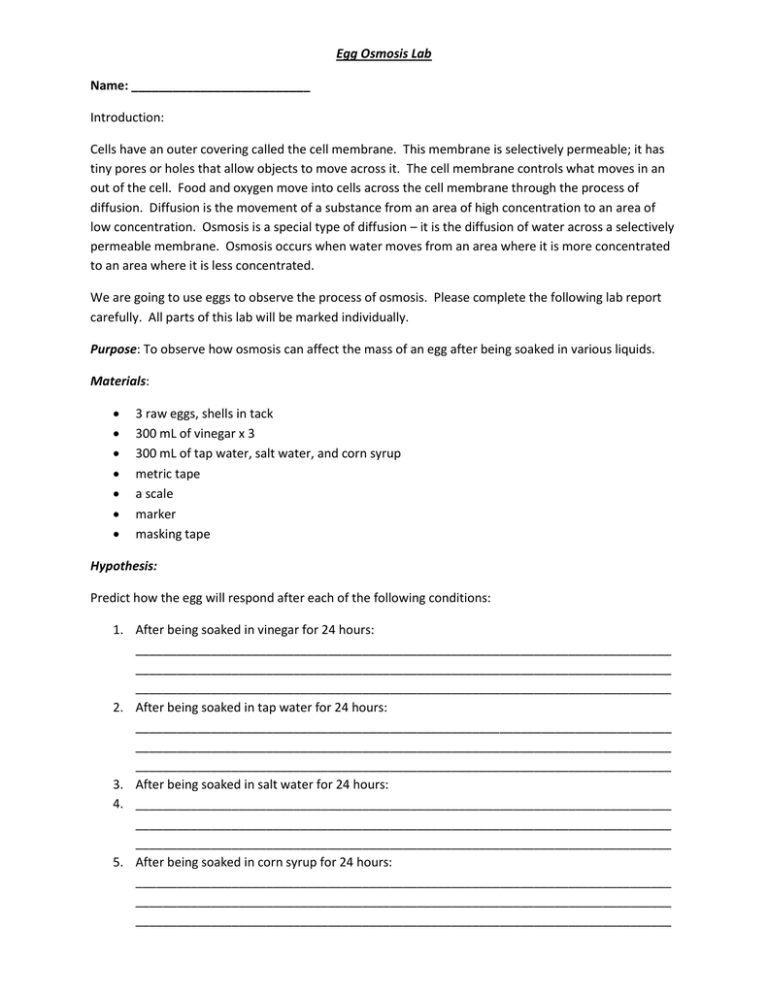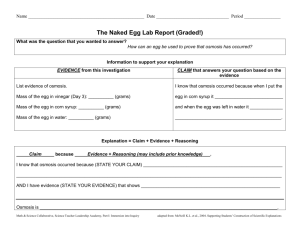Egg Osmosis Lab
advertisement

Egg Osmosis Lab Name: __________________________ Introduction: Cells have an outer covering called the cell membrane. This membrane is selectively permeable; it has tiny pores or holes that allow objects to move across it. The cell membrane controls what moves in an out of the cell. Food and oxygen move into cells across the cell membrane through the process of diffusion. Diffusion is the movement of a substance from an area of high concentration to an area of low concentration. Osmosis is a special type of diffusion – it is the diffusion of water across a selectively permeable membrane. Osmosis occurs when water moves from an area where it is more concentrated to an area where it is less concentrated. We are going to use eggs to observe the process of osmosis. Please complete the following lab report carefully. All parts of this lab will be marked individually. Purpose: To observe how osmosis can affect the mass of an egg after being soaked in various liquids. Materials: 3 raw eggs, shells in tack 300 mL of vinegar x 3 300 mL of tap water, salt water, and corn syrup metric tape a scale marker masking tape Hypothesis: Predict how the egg will respond after each of the following conditions: 1. After being soaked in vinegar for 24 hours: ______________________________________________________________________________ ______________________________________________________________________________ ______________________________________________________________________________ 2. After being soaked in tap water for 24 hours: ______________________________________________________________________________ ______________________________________________________________________________ ______________________________________________________________________________ 3. After being soaked in salt water for 24 hours: 4. ______________________________________________________________________________ ______________________________________________________________________________ ______________________________________________________________________________ 5. After being soaked in corn syrup for 24 hours: ______________________________________________________________________________ ______________________________________________________________________________ ______________________________________________________________________________ Procedure: **wash hands carefully after each step – raw egg can contain salmonella 1. 2. 3. 4. 5. 6. 7. 8. 9. 10. 11. 12. Weigh and record the mass of each egg in the table. Place each egg in individual beakers with 300 mL of vinegar in each one. Allow each egg to soak in the beaker for 24 hours. Record your observations. Gently dry off each egg. Weigh and record the mass of each egg. Clearly label each beaker with masking tape titled tap water, salt water, and corn syrup. Put 300 mL of each liquid in each labelled beaker or jar. Place one egg in each beaker or jar. Allow to sit for 24 hours. Remove eggs from beakers and gently dry off. Weigh each egg and record mass in table. Record observations. Observations: Mass Data Table Egg Circumference cm Vinegar weight in grams Tap Water weight in grams Salt Water weight in grams Corn Syrup weight in grams Vinegar Tap Water Salt Water Corn Syrup 1 2 3 Observation Data Table Egg 1 2 3 Circumference Use a bar graph to graph the changes in mass after each day. (Refer to the bar graph we created in the gummy bear osmosis lab to help). Remember to clearly label your graph. You might need to include a legend. Analysis Questions: Be sure to use appropriate scientific vocabulary when responding to questions. 1. What liquids caused the egg to swell? 2. What liquids caused the egg to shrink? 3. Explain why some eggs swelled and some eggs shrunk using the concept of osmosis. Criteria Knowledge and Understanding Thinking Communication Application Level 1 Demonstrates limited understanding of osmosis and diffusion and how they work in organisms. Uses scientific inquiry to develop a vague hypothesis and draw few conclusions about an experiment involving osmosis. Uses limited scientific vocabulary when communicating the results of an experiment. Organizes information into bar graphs to show comparisons with limited effectiveness. Uses bar graph with limited effectiveness to draw conclusions about an experiment. Level 2 Demonstrates some understanding of osmosis and diffusion and how they work in organisms. Uses scientific inquiry to develop a hypothesis and draw some conclusions about an experiment involving osmosis. Level 3 Demonstrates good understanding of osmosis and diffusion and how they work in organisms. Uses scientific inquiry to develop a hypothesis and draw conclusions about an experiment involving osmosis. Uses some scientific vocabulary when communicating the results of an experiment. Organizes information into bar graphs to show comparisons with some effectiveness. Uses bar graph with some effectiveness to draw conclusions about an experiment. Uses good scientific vocabulary when communicating the results of an experiment. Organizes information into bar graphs to show comparisons with effectiveness. Uses bar graph with good effectiveness to draw conclusions about an experiment. Level 4 Demonstrates thorough understanding of osmosis and diffusion and how they work in organisms. Uses scientific inquiry to develop a strong hypothesis and draw effective conclusions about an experiment involving osmosis. Uses thorough scientific vocabulary when communicating the results of an experiment. Organizes information into bar graphs to show comparisons with limited effectiveness. Uses bar graph with excellent effectiveness to draw conclusions about an experiment.


